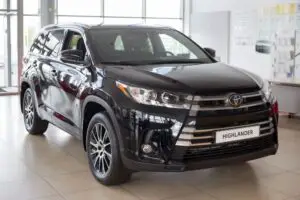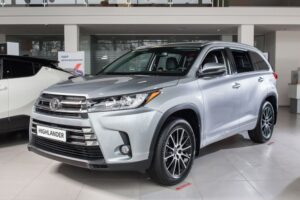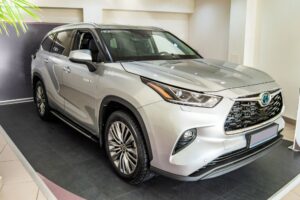Known also as the Toyota Kluger, the Toyota Highlander was released to the public in 2001 and is still going strong to this day, with many people appreciating the lineup but also acknowledging the various problems that surround the model and Toyota cars as a whole.
As you may be aware, Toyota cars often have similar issues, which can rile up the most avid car enthusiasts and force owners to ask, “Why won’t my Toyota Highlander start?”.
The issues that invoke this question lie in the battery and other components, electrical or otherwise.
Some of the main issues that plague the Toyota Highlander are as follows:
- Alternator Issues
- Faulty Fuel Pumps
- Dead Starter Motor
- Low Charged Or Dead Battery
- Old Serpentine Belt
You should try your best to keep a look out for these issues but if you do not know how to identify them or deal with them, then make sure to read this article as I will explain them as best as possible.
Table of Contents
- 1 What Would Cause A Toyota Highlander To Not Start?
- 2 Frequently Asked Questions
- 2.1 Q1. Why Won’t My Toyota Highlander Start With New Battery?
- 2.2 Q2. Why Won’t My Toyota Highlander Start Even With A Jump?
- 2.3 Q3. Why Won’t My Toyota Highlander Start But Lights Work?
- 2.4 Q4. Why Won’t My Toyota Highlander Start But Cranks?
- 2.5 Q5. Why Won’t My Toyota Highlander Start Just Clicks?
- 2.6 Q6. Why Won’t My Toyota Highlander Start In The Cold Weather?
- 2.7 Q7. Why Won’t My Toyota Highlander Start After I Get Gas?
- 2.8 Q8. Why Won’t My Toyota Highlander Start But Radio Works?
- 3 Conclusion
What Would Cause A Toyota Highlander To Not Start?
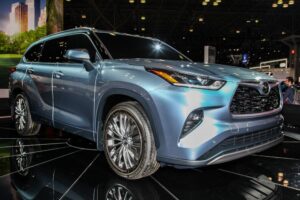
All the systems of the Toyota Highlander need to work together to make sure the car can start and run, so even the slightest issue in any system components, fuel pumps, alternators, batteries, and serpentine belts can lead to major issues which halt the car from starting.
1: Alternator Issues
A faulty alternator is one of the most aggravating problems to solve as many people often confuse the defective alternator as a problem with their battery, getting it jumpstarted or replaced instead of checking the alternator.
This is because the alternator is responsible for charging the battery. If your alternator is not working, your battery constantly runs out of power and needs to be recharged.
Moreover, this can get annoying as you will have to constantly jumpstart your battery only to have it run out of power again.
If you notice a trend in your battery constantly requiring a jumpstart, then it is likely that your alternator is not working properly.
What Should You Do About It?
- The best way to resolve the issue is to completely get a new alternator.
- If you are confident in your abilities, you can disconnect the alternator and try to locate any issues; however, the better option is to take out some time, take the Toyota Highlander to a mechanic, and have the alternator checked out professionally.
- Once the problem has been identified, you can either fix the alternator or replace it entirely.
- Getting a new alternator is a better option as there are always chances that the old alternator may break again.
- From here on out, we should ensure the alternator is properly cleaned and maintained to prevent the issue from repeating.
2: Faulty Fuel Pumps
The fuel does not magically go from the fuel tank to the engine.
Instead, it relies on the intricate working of pumps to push the fuel from the tank to the engine, ensuring that a good amount of fuel is always pushed to the engine.
If your fuel pump is clogged or goes bad, your Toyota Highlander will not have the fuel pressure to turn on the engine.
A damaged fuel pump is likely to make a loud, whining sound which you should be able to identify.
Other signs that you may be dealing with bad or faulty fuel pumps are; stalling, lower mileage, a sputtering engine, and of course, difficulties in starting the Toyota Highlander.
What Should You Do About It?
- If you are still unsure that you have issues with your fuel pump, then you should conduct a pressure check. You can do this by using a circuit tester to check the electrical connections to the fuel pumps.
- If the pressure is less than what it should be, you may have to get your fuel pumps checked out by a mechanic.
- Once again, it is better to have the fuel pumps replaced with new ones rather than opting to fix the old ones as it will be much cheaper and easier to do so and less time-consuming as well.
3: Dead Starter Motor
While it is a rare occurrence, there is always the chance that the starter motor may go bad.
The starter motor is responsible for turning the Toyota Highlander’s engine during the ignition process.
This allows all of the processes necessary for the car to start to happen, so if your starter motor is not working, then it will not be possible to start the Toyota Highlander.
The more you use your Toyota Highlander, the more the heat starts to degrade the starter motor, which increases the winding resistance and makes it harder to spin.
Your best bet to fix this issue will be to take it to the mechanic and leave it to the professionals. This usually results in a replacement motor.
What Should You Do About It?
- As mentioned above, your best option should be to take the Toyota Highlander to a mechanic and have them inspect the starter motor.
- If you can jumpstart your car, then your starter motor is fine. If not, you should consider getting a replacement.
- Once you have a replacement, you need to make sure that the issue does not repeat, in which case you must drive your car in moderation to prevent overheating.
- Regular maintenance also goes a long way to preventing issues as well.
4: Low Charged Or Dead Battery
The most common issue that most cars face is trouble with the battery, so it is no surprise if you find the battery of your Toyota Highlander causing trouble and preventing the car from starting.
Furthermore, the main job of the battery is to supply power to the engine and other components of the car, so it should be obvious that if your battery can not do so, then your car will not be able to start.
There are many factors that need to be managed if you want to make sure that your battery remains in perfect health, such as the weather and how you drive your Toyota Highlander.
I will elaborate more on this later.
What Should You Do About It?
- First of all, you should check if the battery is properly connected or not and also look for any external issues such as corroded wires or corrosion on the battery terminals.
- Then conduct a voltage test. If your Toyota Highlander’s battery fails this test, then it is likely that your battery needs some more juice.
- You can try to jumpstart the car battery if you get your hands on another car with a healthy battery.
- Alternatively, you can have your battery replaced entirely to avoid any issues and not have to worry about jumpstarting the car at all.
- You should, from this point, protect the battery from cold weather and drive your car in a controlled manner.
5: Old Serpentine Belt
As I have discussed, the alternator is responsible for charging the battery of the Toyota Highlander, but the connection between the alternator and the engine is made through the serpentine belt.
This is a rubber belt that drives everything from the alternator, the water pump, and even the AC compressor.
As the days go by, this belt gets worn out and eventually fails to rotate properly.
Moreover, this prevents the alternator from properly recharging the battery of the car, eventually causing the battery to lose power and be unable to start the car.
While wear and tear is natural for the serpentine battery, there are a few ways you can prolong the inevitable, which I will discuss in a bit.
What Should You Do About It?
- If you want to take matters into your own hands, then you can purchase a DIY repair kit for your Toyota Highlander’s serpentine belt, which you can use to repair the belt.
- If this is not to your liking, then you can have it done by a professional.
- On the other hand, you can get a new serpentine belt entirely and avoid having to reuse your old one. This option will allow you to use the belt for a much longer period of time.
- Every time you change the oil of your Toyota Highlander, you should also check the serpentine belt and have it realigned and adjust belt tension if need be.
Frequently Asked Questions
Q1. Why Won’t My Toyota Highlander Start With New Battery?
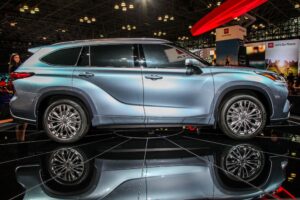
Simply put, your new battery may not have been installed properly, which may have resulted in your car not starting.
Have the battery checked for any loose connections which may be preventing the Toyota Highlander from starting.
Alternatively, the issue may lie in other parts of the electrical system, in which case you should look for any corroded battery terminals or wires along with
Q2. Why Won’t My Toyota Highlander Start Even With A Jump?
Jumpstarting your Toyota Highlander is not the solution to all of your problems.
While jumpstarting your Toyota Highlander can fix the battery if it has a low charge, it will not be able to fix any electrical faults in the car.
You should check to see if there are any faults in the electrical system or the ignition system of the car and have it assessed by a mechanic.
Q3. Why Won’t My Toyota Highlander Start But Lights Work?
The sign of a poorly charged battery is having the lights be able to turn on but not being able to start the Toyota Highlander itself.
This occurs as the battery does not have sufficient charge to start the car.
While a jumpstart may be able to fix this problem, there is always the chance that the problem lies elsewhere and that you need to get it resolved by other means.
Q4. Why Won’t My Toyota Highlander Start But Cranks?
If your Toyota Highlander is cranking, then it should be able to start since all of the electrical systems are in order.
The issue must lie in the fuel system or any other important system of the Toyota Highlander.
You should check for any fuel blockages or issues with the fuel system and inspect the starting motor for any faults and defects which may be preventing your Toyota Highlander from starting.
Q5. Why Won’t My Toyota Highlander Start Just Clicks?
Cranking is a good sign as it lets you know that the main electrical system is working just fine; however, if your Toyota Highlander is simply clicking and not even cranking, then you have a major electrical fault that is preventing your car from starting.
Anything from the alternator to the starter motor and even the battery could be the main cause, so make sure to check these components for any faults.
Q6. Why Won’t My Toyota Highlander Start In The Cold Weather?
The cold weather can slowly degrade the health of your Toyota Highlander until it can no longer even start properly.
It starts by reducing the power output of your battery by slowing down the reactions happening inside it.
The oil in the car starts to thicken up, and the spark plugs also lose their ability to generate a sufficient spark necessary to ignite the fuel, making it difficult to start the engine all around.
Q7. Why Won’t My Toyota Highlander Start After I Get Gas?
It does not matter how much fuel your car has if none of it is reaching the engine.
Even if you have filled the fuel tank to the max, chances are that none of it is even reaching the engine at all.
Blockages caused by cheap fuel and not changing the fuel filter of the Toyota Highlander are likely the issue and should be handled accordingly to resolve the issue.
Q8. Why Won’t My Toyota Highlander Start But Radio Works?
If your battery is low on juice, then there is a good chance that you might not be able to start your Toyota Highlander, but it is possible to start the radio.
Once again, I will recommend that you get a jumpstart if you believe that the battery is low on fuel.
Alternatively, you can even get a new battery entirely if your old battery has been used extensively.
Related: What Are The Worst Years For The Toyota Highlander?
Conclusion
Toyota is making sure to give the Highlander all the support it needs, showing no signs of stopping the production of the model, and constantly upgrading the lineup, but this is still now enough to mitigate the issues which make the customers go “Why won’t my Toyota highlander start?”.
Hopefully, you can put this article to good use and be able to identify the issue that is hurting your Toyota Highlander and be able to resolve it.
Furthermore, you should be able to make sure that such an issue does not occur again, ensuring a smooth driving experience for a long time.

I am Tahir Azam, and I have been writing amazing articles for TaxiHack for as long as I can remember. I know everything that is to know when it comes to automobiles and is always on top of industry news and developments. While I am not an expert by any means, I pride myself on knowing the ins and outs of many different problems and, of course, their solutions. The articles on our website are some of the best and well-researched content that you will find, and I spend countless hours making sure this remains to be true. This is why I ask you to take your time out and read some of my articles, especially if you find a topic that resonates with you or is something you are looking into. This way, you will find the perfect mix of information and tips on your desired topic. Learn more about Tahir.

